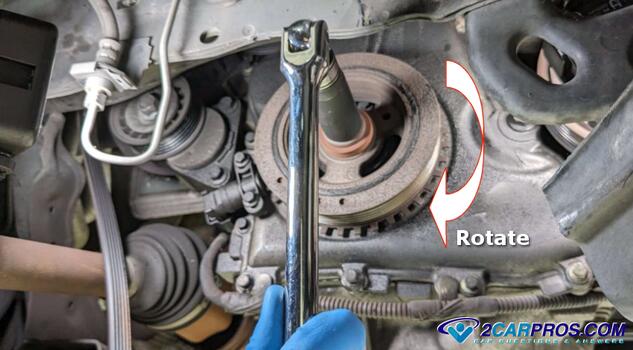One of the more basic tests for an engine that will not crank over is the "manual rotation test". This is used for confirmation that the engine has not suffered a mechanical failure such as a broken piston rod or an engine lock up due to lack of oil. Additionally this guide can be used to help remove an automatic transmission when undoing the torque converter bolts which need to have the flex plate rotated to access. Also, a manual engine rotation works well when checking the engine timing chain marks to confirm a "jump" in crankshaft to camshaft timing. Before installing a used engine it is highly advised to make sure the engine rotates freely before installation.
Don't Be Fooled!
The serpentine belt is connected to the front of the engine via the harmonic balancer. This belt drives the engine accessories such as the power steering pump, alternator, water pump and air condition compressor and if any of these locks up it will stop the engine from rotating. So, if you suspect the engine is locked up try removing the serpentine belt and rechecking the engine.
What Goes Wrong?
An engine can have many problem that will keep it from rotating (cranking) over which I have listed from the most popular to the least:
- Lack of Engine Oil: This is a popular problem due to the complacency of today's drivers and a lack of service at refueling stations. Though today's engine are made with higher quality materials and more precise machining procedures the oil level needs to be checked and the engine oil changed along with the filter at regular intervals.
- Overheated Engine: If the cooling system has a sudden failure such as a blown radiator hose the engine coolant will drain from the system allowing the engine to get hotter than it was designed for. This condition causes the pistons to "swell" and get stuck or seized inside the cylinder bore. This condition can subside and the engine will rotate again but it may not start or have low power due to low compression.
- Head Gasket Leak: There is a gasket located between the cylinder block and cylinder head that controls coolant between the two. If this head gasket fails it allows coolant to fill the cylinder and combustion chamber stopping the piston movement in the compression stroke.
- Mechanical Failure: The piston rod which attaches the piston to the crankshaft is a major point of failure and can wedge itself between the block and the crankshaft stopping the engine from rotating and can be known as "threw a rod". Additionally, if an intake or exhaust valve breaks it can drop into the combustion chamber stopping the piston movement.
Performing the Engine Rotating Test
- Locate the front of the engine, down low, there will be a harmonic balancer which will have a serpentine belt attached to it. In the center of the balancer is a large bolt which will very in size depending on the manufacturer, usually between 22mm and 24mm.
- You may need to remove the front under shield of the to access the front of the engine.
- Attach a socket to the bolt and a short extension which should be 1/2 drive to help handle the force needed.
- Connect a breaker bar which is a long bar socket wrench for leverage and turn the engine clockwise only. You don't want to turn the engine backwards because the timing chain tensioner can retract and the engine may jump time.
- Continue to rotating the engine for two complete 360 degree rotations to ensure the engine is free and clear, then you are all set and the test is complete.
Conclusion
This test is beneficial when troubleshooting an engine that will not crank or turn over, also when installing a pre-owned or rebuilt engine is it best to make sure the engine rotates before the work begins. Use this method to help remove an automatic transmission torque converter bolts.
Watch the Video!
Please watch this video of the job being done to glean additional helpful information.
Credits
This guide knowledge base was created by the 2CarPros Team, and by Ken Lavacot: Automobile repair shop owner and certified master automobile technician of over 30 years. If you have question or need help please ask one of our experts we are happy to help. Please visit our 2CarPros YouTube Channel.





